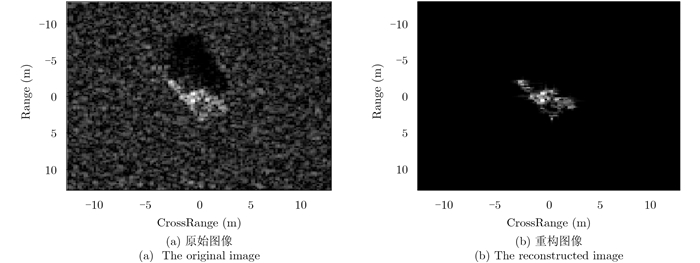Matching of Attributed Scattering Center and Its Application to Synthetic Aperture Radar Automatic Target Recognition
-
摘要: 属性散射中心是合成孔径雷达 (Synthetic Aperture Radar, SAR) 图像的一个重要特征。该文提出了一种属性散射中心匹配方法并将其运用于SAR目标识别中。该方法首先基于属性散射中心模型提取待识别SAR图像和模板SAR图像的属性散射中心,进而采用Hungarian算法实现散射中心的匹配。在建立的匹配关系的基础上,设计了一种稳健的散射中心匹配度度量方法计算待识别散射中心与各类模板散射中心的匹配度。该匹配度准则充分考虑了单个散射中心强弱、匹配对强弱以及漏警、虚警带来的影响,对于散射中心集的匹配度的评价更为全面。基于Moving and Stationary Target Acquisition and Recognition (MSTAR) 数据集的实验验证了方法的有效性。
-
关键词:
- 合成孔径雷达 /
- 目标识别 /
- 属性散射中心匹配 /
- Hungarian算法 /
- 匹配度度量方法
Abstract: Attributed scattering center is one of important features of Synthetic Aperture Radar (SAR) image. In this paper, a method for the matching of attributed scattering centers and its application to SAR target recognition is proposed. First, the attributed scattering centers of the test SAR image and template SAR images are extracted on the basis of the attributed scattering model. Second, the Hungarian algorithm is employed to match the two scattering center sets. Based on the one to one correspondence, we design a new similarity measure to evaluate the similarity between the two scattering center sets that will decide the target type of the test image. The similarity measure considers the effects of each individual scattering center, single matching pair, and missing alarms and false alarms; thus, it is more comprehensive. The experiment based on moving and stationary target acquisition and recognition database demonstrates the validity of the proposed method. -
表 1 分配代价矩阵
Table 1. The cost matrix for Hungarian matching
Y1 Y2 $\begin{array}{*{20}{c}}\cdots \end{array}$ Yn MA X1 C11 C12 $\begin{array}{*{20}{c}}\cdots \end{array}$ C1n M1 $\infty $ $\begin{array}{*{20}{c}}\cdots \end{array}$ $\infty $ X2 C21 C22 $\begin{array}{*{20}{c}}\cdots \end{array}$ C2n $\infty $ M2 $\begin{array}{*{20}{c}}\cdots \end{array}$ $\infty $ $\vdots $ $\vdots $ $\vdots $ $ \ddots $ $\vdots $ $\vdots $ $\vdots $ $ \ddots $ $\vdots $ Xm Cm1 Cm2 $\begin{array}{*{20}{c}}\cdots \end{array}$ Cmn $\infty $ $\infty $ $\begin{array}{*{20}{c}}\cdots \end{array}$ Mm FA F1 $\infty $ $\ldots $ $\infty $ $\infty $ $\infty $ $\ldots $ $\infty $ $\infty $ F2 $\ldots $ $\infty $ $\infty $ $\infty $ $\ldots $ $\infty $ $\vdots $ $\vdots $ $ \ddots $ $\vdots $ $\vdots $ $\vdots $ $ \ddots $ $\vdots $ $\infty $ $\infty $ $\ldots$ Fn $\infty $ $\infty $ $\ldots$ $\infty $ 表 2 属性的不确定性建模
Table 2. The modeling of attribute uncertainty
属性类别 均值 方差 方位向x x0 ${\sigma ^2} = {\rm{CR}}{{\rm{R}}^2}$ 距离向y y0 ${\sigma ^2} = {\rm{R}}{{\rm{R}}^2}$ 归一化幅度|A| |A0| ${\sigma ^2} = 0.1$ 表 3 模板集和测试集
Table 3. The template set and testing set
模板集 样本数量 测试集 样本数量 BMP2(SN_C21) 233 BMP2(SN_C21) 195 BMP2(SN_9566) 232 BMP2(SN_9566) 196 BMP2(SN_9563) 233 BMP2(SN_9563) 196 BTR70(SN_C71) 233 BTR70(SN_C71) 196 T72(SN_132) 232 T72(SN_132) 196 T72(SN_812) 231 T72(SN_812) 195 T72(SN_S7) 228 T72(SN_S7) 191 表 4 本文方法的识别结果
Table 4. The recognition result of the proposed method
目标类型 识别结果 Pc(%) BMP2 BTR70 T72 BMP2(SN_9563) 191 2 2 97.95 BMP2(SN_9566) 195 1 0 99.49 BMP2(SN_C21) 192 2 2 97.96 BTR70 5 188 3 95.92 T72(SN_132) 8 1 187 96.91 T72(SN_812) 1 0 194 99.49 T72(SN_S7) 4 1 186 97.31 Average (%) 97.88 表 5 3种方法的识别性能对比
Table 5. The comparison of the three methods
方法 识别率 (%) 消耗时间 (ms) 本文方法 97.88 10.2 方法一 93.46 3.5 方法二 96.92 20.3 -
[1] 黄培康, 殷红成, 许小剑.雷达目标特性[M].北京:电子工业出版社, 2005: 22–24.Huang Pei-kang, Yin Hong-cheng, and Xu Xiao-jian. Radar Target Signature[M]. Beijing: Publishing House of Electronics Industry, 2005: 22–24. [2] Keller J B. Geometrical theory of diffraction[J]. Journal of the Optical Society of America, 1962: 52(2): 116–130. doi: 10.1364/JOSA.52.000116 [3] Gerry M J, Potter L C, and Gupta I J. A parametric model for synthetic aperture radar measurements[J]. IEEE Transactions on Antennas and Propagation, 1999, 47(7): 1179–1188. doi: 10.1109/8.785750 [4] Chiang H-C, Moses R L, and Potter L C. Model-based classification of radar images[J]. IEEE Transactions on Information Theory, 2000, 46(5): 1842–1854. doi: 10.1109/18.857795 [5] 唐涛, 粟毅.散射中心特征序贯匹配的SAR图像目标识别方法[J].系统工程与电子技术, 2012, 34(6): 1131–1135. http://www.cnki.com.cn/Article/CJFDTOTAL-XTYD201206011.htmTang Tao and Su Yi. Object recognition in SAR imagery using sequential feature matching of scattering centers[J]. System Engineering and Electronics, 2012, 34(6): 1131–1135. http://www.cnki.com.cn/Article/CJFDTOTAL-XTYD201206011.htm [6] Sirui Tian, Kuiying Yin, Chao Wang, et al.. An SAR ATR method based on scattering center feature and bipartite graph matching[J]. IETE Technical Review, 2015, 32(5): 364–375. doi: 10.1080/02564602.2015.1019941 [7] Bhanu B and Lin Y Q. Stochastic models for recognition of occluded targets[J]. Pattern Recognition, 2003, 36(12): 2855–2873. doi: 10.1016/S0031-3203(03)00182-1 [8] Dungan K E and Potter L C. Classifying transformationvariant attributed patterns[J]. Pattern Recognition, 2010, 43(11): 3805–3816. doi: 10.1016/j.patcog.2010.05.033 [9] Dungan K E and Potter L C. Classifying sets of attributed scattering centers using a hash coded database[C]. Proceedings of Algorithms for Synthetic Aperture Radar Imagery XVII, SPIE, Florida, 2010: 7737R01–7737R11. [10] Zhou Jianxiong, Shi Zhiguang, Chen Xiao, et al.. Automatic target recognition of SAR images based on global scattering center model[J]. IEEE Transactions on Geosciences and Remote Sensing, 2011, 49(10): 3713–3729. doi: 10.1109/TGRS.2011.2162526 [11] Kim Taejoon and Dong Miaomiao. An iterative Hungarian method to joint relay selection and resource allocation for D2D communications[J]. IEEE Wireless Communications Letters, 2014, 3(6): 625–629. doi: 10.1109/LWC.2014.2338318 [12] Li D, Zhang G, Wu Z, et al.. An edge embedded markerbased watershed algorithm for high spatial resolution remote sensing image segmentatio[J]. IEEE Transactions on Image Processing, 2010, 19(10): 2781–2787. doi: 10.1109/TIP.2010.2049528 [13] Jing M, Zhou X, and Qi C. Quasi-Newton Iterative Projection algorithm for sparse recovery[J]. Neurocomputing, 2014, 144: 169–173. doi: 10.1016/j.neucom.2014.04.055 [14] Chen J, Li Y, Wang J, et al.. Adaptive CLEAN algorithm for millimetre wave synthetic aperture imaging[J]. IET Image Processing, 2015, 9(3): 218–225. doi: 10.1049/iet-ipr.2014.0443 [15] 陶勇, 胡卫东.基于图像域的属性散射中心分析[J].信号处理, 2009, 25(10): 1510–1514. doi: 10.3969/j.issn.1003-0530.2009.10.004Tao Yong and Hu Wei-Dong. Analysis of attributed scattering center based on image domain[J]. Signal Processing, 2009, 25(10): 1510–1514. doi: 10.3969/j.issn.1003-0530.2009.10.004 [16] 徐牧, 王雪松, 肖顺平.基于Hough变换与目标主轴提取的SAR图像目标方位角估计方法[J].电子与信息学报, 2007, 29(2): 370–374. http://www.cnki.com.cn/Article/CJFDTOTAL-DZYX200702024.htmXu Mu, Wang Xue-song, and Xiao Shun-ping. Target aspect estimation in SAR imagery based on Hough transform and major axis extraction[J]. Journal of Electronic & Information Technology, 2007, 29(2): 370–374. http://www.cnki.com.cn/Article/CJFDTOTAL-DZYX200702024.htm -



 作者中心
作者中心 专家审稿
专家审稿 责编办公
责编办公 编辑办公
编辑办公

 下载:
下载:












